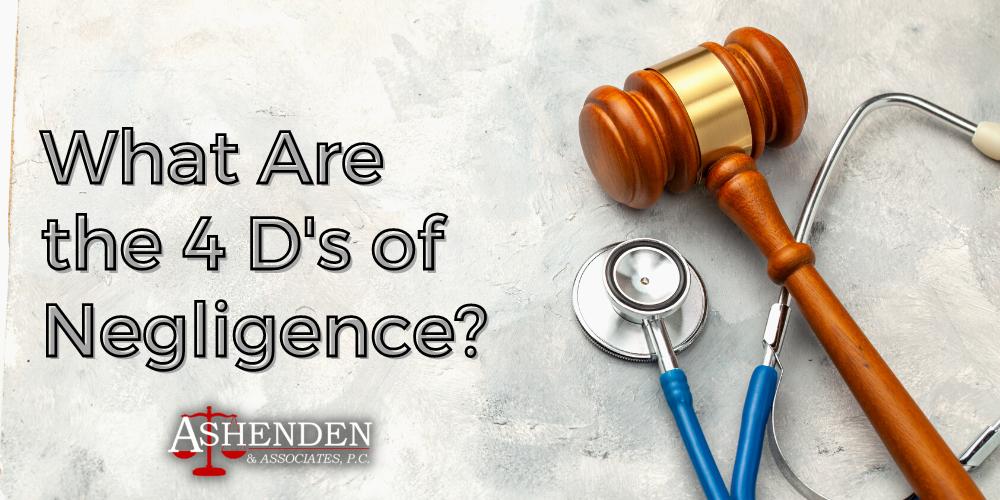Out of all the types of personal injury cases out there, medical malpractice cases are often the most difficult to win. That’s because the human body and the medical system are very complex, and it takes much more than a good lawyer to figure out what went wrong. To have a successful medical negligence claim, you must hire a good lawyer and a medical expert to help prove medical negligence. Together, the lawyer and the medical expert must prove the 4 D’s of negligence for a victim to obtain financial recovery in a medical malpractice claim.
Below, our Sandy Springs personal injury lawyers break down each element of the four D’s of medical negligence.

If you or a loved one has suffered a major injury, illness, or wrongful death as a result of negligent medical care, you may have grounds to file a medical malpractice claim. Call 770-394-8909 to schedule a free consultation with a Sandy Springs medical malpractice attorney at Ashenden & Associates today.
What is Medical Malpractice?
Medical malpractice occurs when a physician commits negligence – whether that’s through action or inaction – that results in the injury, illness, or death of the patient. Common examples of medical malpractice include:
- Missed or delayed diagnosis of a major medical condition
- Knowingly performing unnecessary procedures on a patient
- Leaving a surgical instrument or surgical tool inside a patient’s body
- Failing to inform a patient of all the potential risks associated with a major procedure
- Medication errors, such as giving a patient the wrong dose or the wrong medication
- Birth injuries such as cerebral palsy or brachial plexus injuries
- Chiropractic errors such as causing a vertebral artery dissection (VAD) during spinal manipulation
- Anesthesia or epidural errors
- And so much more
If you’ve sustained a serious injury because of a surgical error, contact our Sandy Springs surgical error lawyers for a free consultation.
What Are the 4 D’s of Negligence?
To recover financial damages through a medical malpractice case, you must first hire an experienced medical malpractice lawyer. From there, you must prove that the four D’s of medical negligence occurred in your case.
The four Ds of medical negligence are duty of care, duty dereliction, direct cause, and damages.
Duty of Care
The first step in proving medical negligence is proving an established relationship between doctor and patient. This is the easiest step in a medical negligence case because a doctor-patient relationship can easily be proven through medical records.
The next step is establishing the duty of care that all healthcare providers owe to their patients.
The 4 D’s of negligence can be applied to almost every type of personal injury case, such as car accidents, slip and fall accidents, and even wrongful death accidents. As human beings, we should all provide reasonable care to each other by driving safely, maintaining safe premises, etc.
Medical professionals are held to an even higher standard called the medical standard of care in medical malpractice cases. They must provide reasonably sound and competent medical care to all patients that do not result in physical harm.
Duty Dereliction
The next element in the 4 D’s of medical negligence is duty dereliction. This means the doctor failed to provide the patient with safe, correct, or competent medical treatment. But how do you prove that a medical professional violated the duty of care in a medical negligence claim?
To prove duty dereliction, medical negligence lawyers usually hire one or more medical experts to determine whether the medical standard of care was violated. More specifically, a medical expert must determine whether the doctor provided the same level and type of care that another competent physician would have provided in the same circumstances.
Let’s say that your baby suffered a significant birth injury due to a doctor’s negligence. In a medical malpractice case like this, our Sandy Springs birth injury attorneys would hire another obstetrician to serve as a medical expert.
The job of this obstetrician would be to analyze the details of the medical negligence case and ask themselves: “Would I, a competent obstetrician, have treated this patient the same way in the same circumstances?” If the answer is no, medical negligence may have occurred in this birth injury case.
Our Sandy Springs Cerebral Palsy attorneys often work closely with such medical experts.
Direct Cause
Direct causation is the next element in the 4 D’s of medical negligence. Here, a medical malpractice lawyer must prove that a patient suffered physical harm due to a medical professional’s actions.
Let’s use a birth injury case as an example again. Let’s say that a baby gets stuck on its way out of the birth canal. The doctor immediately resorts to forcefully pulling the baby out of the canal with metal forceps, which crush the baby’s head. The baby comes out with a skull fracture and a traumatic brain injury. In this case, the medical provider’s negligence directly caused the baby’s injuries, and our Sandy Springs traumatic brain injury lawyers could help families pursue damages.
Now, let’s say this same healthcare provider successfully delivered the baby without the use of forceps, so the baby comes out without any injuries. Later, the mother picks up her baby and drops it, causing the baby to suffer head injuries. This mother could not sue her hospital or any other medical professionals for this injury because the direct cause of the injury resulted from her own actions.

Damages
The last element of the four Ds of medical negligence is damages. Damages are the losses that a medical negligence victim suffers due to their injuries. Victims deserve to receive fair compensation for all the damages that they suffer.
These damages fall into three categories:
- Economic damages
- Non-economic damages
- Punitive damages
Economic Damages
Economic damages are the measurable costs incurred by the victim due to their injury. The amount of financial compensation recovered for damages will depend on the severity and surrounding factors of the claim.
Economic damage examples include:
- Present and future lost wages
- Loss of earning capacity
- Past and future medical expenses
- Past and future physical therapy expenses
- Necessary medical equipment such as wheelchairs, prosthetics, and/or any other assistive devices
- Property damages
- Legal fees
- Funeral and burial expenses if the accident resulted in wrongful death
- Counseling expenses
Non-Economic Damages
Non-economic damages usually do not have monetary value. Even still, personal injury and medical malpractice case victims deserve to be justly compensated. A few examples of non-economic damages are:
- Physical pain and suffering
- Loss of consortium
- Loss of quality of life
- Psychological and emotional distress
A victim of a medical negligence claim may never fully heal. They can be affected by the trauma of the incident for the rest of their life. That’s why Sandy Springs medical negligence lawyers at Ashenden & Associates fight so hard for victims to receive full compensation for both economic and non-economic damages.
Punitive Damages
The laws in Georgia permit judges and juries to award punitive damages to punish, penalize, or deter the negligent party for the act in which the victim’s injury occurred.
Judges usually award punitive damages less often than economic damages or non-economic damages. Victims have a better chance of receiving large punitive awards in cases where medical companies or equipment manufacturers disregard information that suggests the product they produce will likely cause harm to unsuspecting consumers.
If you would like to pursue punitive damages, it is best to contact the team of personal injury lawyers at Ashenden & Associates. One of our experienced attorneys can help determine what types of compensation you may be eligible for based on Georgia state law. We can also assist you with filing a claim, advising you, and representing you through the entire legal process.

Sandy Springs Medical Malpractice Lawyers
If you or a loved one has suffered major injury, illness, or wrongful death due to the negligence of a medical treatment provider, you may have grounds to pursue legal action. A Sandy Springs medical negligence lawyer at Ashenden & Associates can help you gather sufficient evidence to prove that the four D’s of medical negligence occurred in your case. That way, you can obtain justice and a fair settlement for your suffering. Call our legal team today at 770-394-8909 to schedule a free case evaluation.

